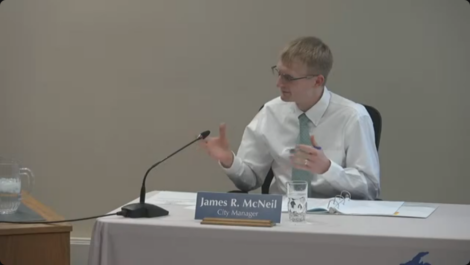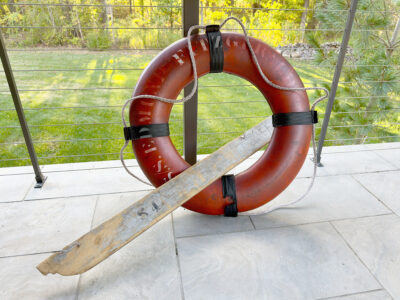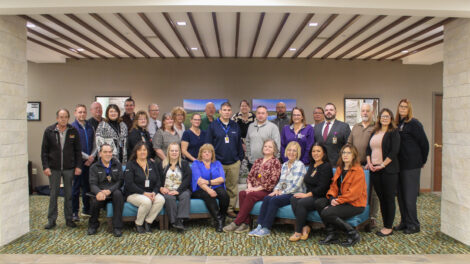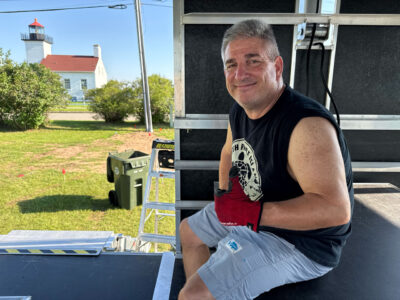Stargazers wanted
Telescopes available for loan at local libraries

Clarissa Kell | Daily Press Dan Young, co-chair of the Delta Astronomical Society, demonstrates how to properly hold and carry the Star Blast telescope at the Escanaba Public Library Wednesday. The Library Telescope Program is a new partnership Delta Astronomical Society has with three area libraries, all thanks to a grant provided by the Community Foundation for Delta County.
ESCANABA — Three local libraries will soon no longer be just for bookworms, but for stargazers, as well.
The Escanaba Public Library, Gladstone Public Library and Hannahville Community Library, each have a Star Blast telescope that will soon be available for patrons of the library to sign out for nighttime viewing of the stars.
The Delta Astronomical Society (DAS) initiated the Library Telescope Program at the libraries and bought the telescopes after receiving a grant from the Youth Advisory Committee of the Community Foundation for Delta County.
Dan Young, co-chair of DAS, said he found out about the Library Telescope Program four years ago when he was reading an article about the 8,000 telescopes around the United States located at local libraries for people to check out.
He noted now, there are around 30,000 telescopes within the program that spans across the United States, Canada and other countries.
“When I read through it, I thought ‘Man, that would be really cool. Our club needs something new to do again.’ So I went back and proposed this, we thought about it and decided we could do this and looked at a couple ‘scopes,” Young said.
He explained it took a couple years to get the program to take off because they had to get funding, as the club did not have enough funds for all the equipment needed.
DAS was awarded a $1,400 grant from the Community Foundation for Delta County, Youth Advisory Committee, which Young said helped pay for the three table-top telescopes and some of the accessories.
Although the program and telescopes come ready to use, the Delta Astronomical Society did some modifications to the program itself and the telescopes.
Young said they did modifications to the telescope to make it easier to use and more difficult for someone to mess up the configurations. He added the manual for the program wasn’t written in terms everyday people would understand, so he rebuilt the manual to walk people through the process of using the telescope step by step.
The instructional manuals go with the telescope when they’re checked out. The telescope and the manual are packed with additional accessories and informational guides.
With every telescope, there is an orange bag with a headlamp, a mini instructional manual, a guide to the night sky map, a red dot light and a dust pen for the eyepiece.
Within the big instructional manual, there are an abundance of materials for stargazers to use — including a moon map, sky map, observing notes, lists of things to see in the sky, sky calendar for the current month and a list of Young’s favorite 20 objects to view in the night sky with the telescope.
The Star Blast telescope will allow people to get a closer look at the night sky, as it is only intended to be used at night. Young was very adamant in the dangers of using the telescope during the day.
“This is not intended for use during the daytime,” Young said. “This telescope all by itself without a lens in it — just because of the size of the mirror — gathers 250 times as much light as your eye.”
He added with the zoom on the lens set at 8 mm, the Sun’s light is concentrated to nearly 2,000 its normal strength, meaning using the telescope during the day will damage your eyes.
From the moons of Jupiter and the rings of Saturn to the craters of our Moon and constellations, the reflecting telescope with a 4.25 inch mirror will open up the night sky to those interested.
Young said the reason why the Delta Astronomical Society was so interested in starting the program in the area is because we are losing the night sky to light pollution at an alarming rate and there is a growing disconnect to the sky despite the fact the stars and planets have deep roots in our heritage.
“So it was kind of like, let’s help people to retrieve the night sky, let’s help people to learn something about the nature that surrounds them — because we have a gift, this incredible gift up here. We have one of the last places east of the Mississippi where you can drive maybe a half hour 10 minutes, half hour from town and be able to see things that others can’t see. They just can’t see it because they’re completely washed out by light,” Young said.
Although as of right now the local Library Telescope Program is just three libraries, Young said he believes it will be so successful that they’ll have to start looking for more grant money to expand it to more libraries.
Caroline Stacey, the executive director of the Escanaba Public Library, said they are very pleased to be one of the libraries partnering with the Delta Astronomical Society with the innovative program.
“I think it’s a great opportunity for people to be able to try something they might not otherwise be able to try, and get out there and have some fun and learn something new,” she said
The Escanaba Public Library staff received training on their new telescope Wednesday.
Stacey said the Escanaba Public Library telescope will become available for the public to utilize on Sept. 3.
“It does need to be checked out under an adult card,” she said.






